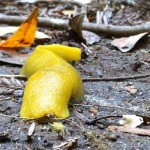I love pie, both the baking and the eating of it. I also love pumpkin, and so Thanksgiving always provide a wonderful opportunity to combine my two loves into one glorious dish.
This morning, I happily pulled out my pumpkin-pie-making ingredients and started the preparation process. I use vegetable shortening in my pie crusts. It contains partially-hydrogenated oils and is no doubt horribly bad for you, but I tend to think it makes the flakiest crust.
Is there any science that could back up this assumption?
After some researching, it appears the consensus is actually that lard makes a flakier crust than shortening. The water in lard turns into steam during the baking process, and as it escapes it lifts up the layers of crust, creating the desired flaky texture.
But as with everything in life, balance is key, and too much water can be a bad thing. Water will interact with the proteins in flour to form gluten. Too much gluten and you’re left with a toughened crust. Butter, which has a higher H2O content than lard, can be tricky to use in pie crusts.
I admit I’ll probably stick with my tried and true waterless vegetable shortening. I couldn’t, after all, store a jar of lard in my kitchen cabinet for years without it going bad. And perhaps more important than the chosen fat is the method of preparation. Below are my mother’s three golden, crust-making guidelines, which haven’t failed me yet.
1.) Use COLD water (you don’t want the fat to melt before the crust is baked)
2.) Use as little water as possible to make it all stick together (otherwise you get a soggy, gluey crust)
3.) Minimize the amount of mixing and handling of the dough (overworked dough can also turn out tough)









That pie looks amazing.. nice post
Cooks Illustrated recommends adding a splash of vodka along with the water. The alcohol keeps gluten from forming as you work the dough and it evaporates while the crust bakes. The result? A tender, flaky pie crust with no trace of your secret ingredient.
http://www.seriouseats.com/recipes/2007/11/cooks-illustrated-foolproof-pie-dough-recipe.html
Thanks for the interesting tip! I’ll have to try that sometime.